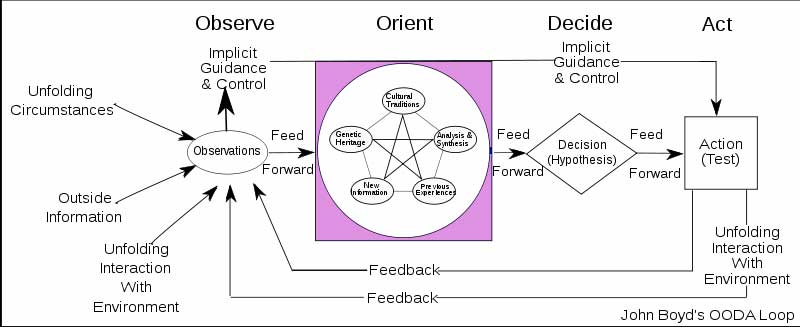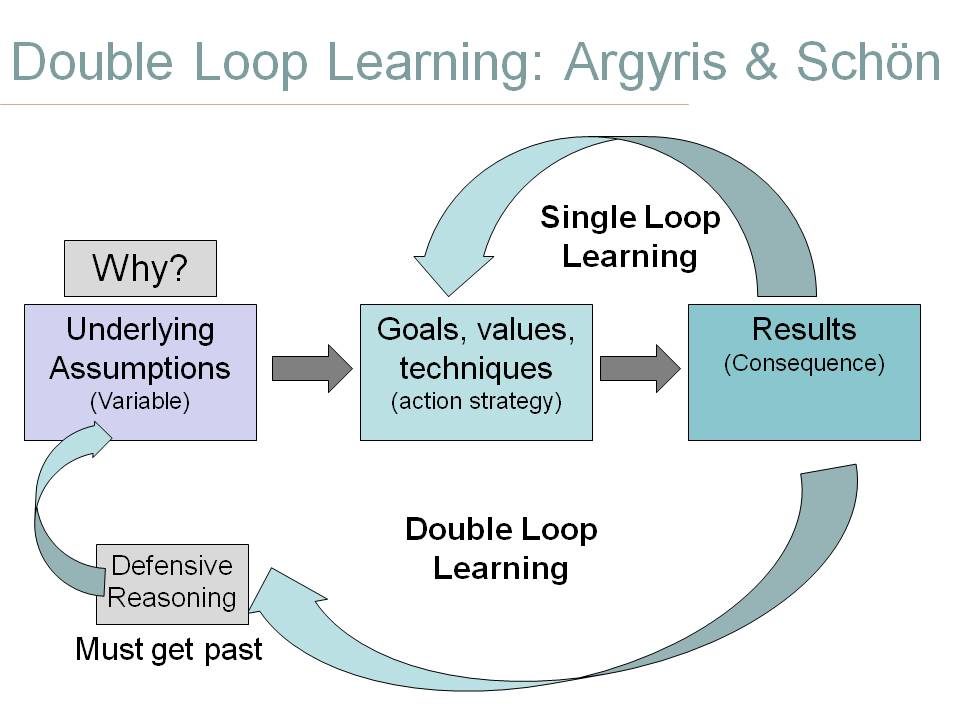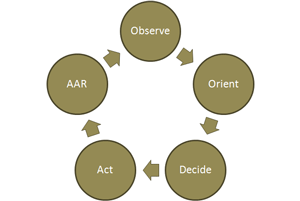In my last post I talked about getting more out of AARs by incorporating them with informal learning and social media tools and then pushing it with formal learning in order to capture lessons learned. This approach allows you to set up a learning strategy that is a real process rather than a one time event. Similar approaches can be done with the OODA loop.
Although originally developed for fighter pilots and then adapted by the Armed Forces, Boyd's OODA Loop is now used by organizations as a decision-making tool that a person or team cycles through as rapidly as possible to help them to stay ahead of their competitors.

It is composed of four actions (Observe, Orient, Decide, Act).
Observe
In this part of the action loop the observer scans the environment in order to gather information and learn about it. However, in this day of abundant information, think more of applying the right filters to gather the information that will be most useful to you. As Clay Shirky notes, “It's Not Information Overload. It's Filter Failure:”
While we are still far from having the perfect filters, we are at least heading in the right direction. For example, I have a list of some of the resources that I use, to include on-line publications, discussion groups, web sites, and blogs that provide me with information about the learning industry. The ones with RSS feeds provide the most value as they feed into my primary browser (Safari) and its is set up so that I only get a small portion of the content. Thus I can quickly scan the latest feeds and then click on them if I determine they have information that interests me. Organizations can help their workers by setting up master portals of relevant links and feeds for each of their various workgroups, and then using a learning platform to help the workers to select the ones that pertain to them the most so they can build their own personal learning environment (PLE) for scanning their environment.
Another useful tool is the ones that belong in the microblogging category, such as Twitter or Yammer, that not only allows our network to send us relevant information and vice-versa, but also allows us to ask for help when we are trying to find information. This may also require a learning platform that will help the workers to learn to send useful information without flooding their coworkers with useless information.
In addition, organizational blogs allow the workers to easily publish their observations so that others may benefit from them. An added benefit is that the readers can provide comments so that the observer/writer receives feedback as discussed in the next part of the action loop — Orient.
Orient
The second part of the action loop is synthesizing the data and information gathered during "observing" into a mental image of the circumstances. As more information is received, you "deconstruct" old images and "create" new images. Within this part of the action loop you have to question past beliefs to see if they still hold true when compared to the new information.
This is perhaps the hardest part of the four actions because we basically fail to ask the right questions and to question our beliefs. For example, Chris Argyris discovered that even highly educated adults stick with Single-Loop Learning rather than using Double-Loop Learning by questioning underlying assumptions:

Another example is the Army, who is best known for creating teams rather than groups, having to create a special environment (AAR) so that the troops could learn from their mistake rather than playing the blame game.
Boyd also noticed this phenomenon in that he spent most of his time emphasizing orient in the OODA loop.
The learning profession also shows this trait of failing to orient themselves in that they rush through the analysis part of a project so fast they fail to properly align the learning platform with real business needs. Secondly, they fail to scan the environment far enough ahead, so rather than designing learning processes, they end up with a learning event that fails to transfer to the workplace. And finally, they fail to evaluate their original beliefs, thus rather than capturing lessons learned, they are doomed to a cycle of repeating their mistakes. No wonder we always hear the old mantra, “ADDIE must die!” — we would rather rush ahead with ill-designed rapid development programs that simply concentrate on development and delivery, rather than properly orientating ourselves to the present environment.
Not only do we fail to question our beliefs, but when we ask others for feedback, they normally evaluate before trying to fully understand. Carl Rogers discovered five main categories of feedback. They are listed below in the order in which they occur most frequently in daily conversations:
- Evaluative: Making a judgment about the worth, goodness, or appropriateness of the other person's statement.
- Interpretive: Paraphrasing - attempting to explain what the other person's statement means.
- Supportive: Attempting to assist or bolster the other communicator.
- Probing: Attempting to gain additional information, continue the discussion, or clarify a point.
- Understanding: Attempting to discover completely what the other communicator means by her statements.
Notice that we often make judgments more often than we try to understand.
Thus a formal learning strategy is needed to help the workers develop skills that allow them to question their beliefs and asking probing questions to see if their beliefs are still valid. In addition, this needs to stretch in the other direction so that when others ask for our opinions, we use the five categories of feedback in the proper direction — we gain a level of understanding by using probing, supportive, and interpretive feedback before we provide an evaluation.
Secondly, the microblogging tools mentioned in the Observing portion of the action loop can be used just as effective, if not more, to get the a broader range of opinions from others.
In addition, the use of wikis or other social editing tools, allow teams performing the OODA Loop to rapidly edit group documents as they reorient themselves.
Decide
The use of PLEs with RSS feeds, blogs, microblogging tools, and wikis in the OODA loop allows the workers to consider all the options and select a subsequent course of action.
Act
This is where you carry out the conceived decision. Once the result of the action is observed, you start over. However, before you do, capture lessons learned by using an AAR so that learning becomes part of the natural process:

Note that in combat (or when competing against your competitors), you want to cycle through the four action steps faster and better than the enemy, hence, it is a loop.
2 comments:
I know I'm going to enjoy this, and apologies for not reading it sooner!
Yes! Exactly:
"Thus a formal learning strategy is needed to help the workers develop skills that allow them to question their beliefs and asking probing questions to see if their beliefs are still valid"
Much of the informal/formal learning debate is couched in Theory X vs Theory Y turns.
But we still need formal systems to defeat the cognitive fallacies. Half of us are fighting the wrong enemy...
Post a Comment